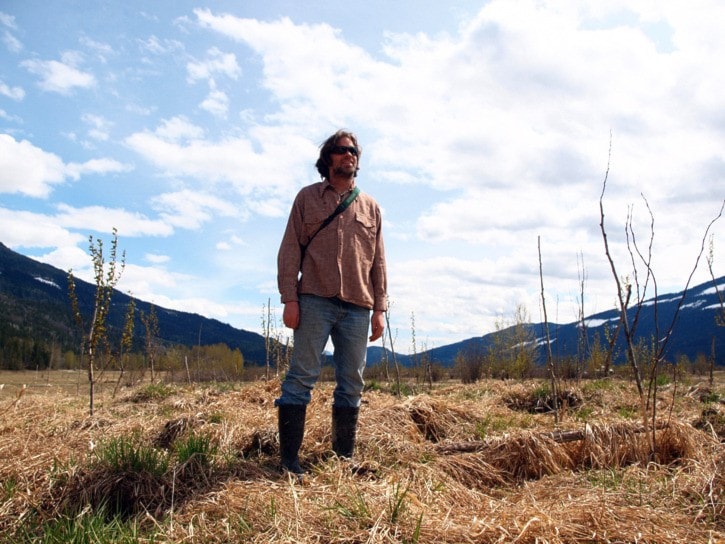This is the first article in a series about the Columbia Water Use Plan. The long-term study, launched in 2008, aims to look at the impact of changing reservoir levels on fish, birds, mammals, vegetation, human recreational use and more.
It’s a warm sunny afternoon on the flats at 9 mile; the forecast of rain didn’t come true. The terrain looks normal for the area in a time of low water on the Arrow Lakes Reservoir – thick grass cut up by roads and other tracks. In a few areas, an abundance of sticks are staked in the ground.
In the distance, a small excavator is shuffling back and forth, digging up the ground while a worker drives the stakes into loosened ground. It’s for the BC Hydro re-vegetation project, a part of the Columbia Water Use Plan (CWUP) designed to increase habitat and bio-diversity up and down the reservoir.
I arrive with Jen Walker-Larsen and Doug Adama of BC Hydro and we’re greeted at the site by Randy Moody, a consultant with Keefer Ecologogists, a company that specializes in ecological restoration. With his shaggy hair and three-day beard, Moody looks the part of the field ecologist. He holds a masters degree from the University of British Columbia, where he studied whitebark pine – a species that grows mostly in the sub-alpine areas of the mountains.
He’s in Revelstoke to supervise the planting of cottonwood stakes and sedges in the upper levels of the Upper Arrow Lake drawdown zone. Working in the river valley is something new to him.
The goal of the project, according to CWUP is to “enhance sustainable vegetation growth in the drawdown zone and provide benefits to littoral productivity, large river habitat, wildlife habitat, shoreline erosion and archaeological site protection.”
“It’s the first project of its kind that I know of,” said Moody.
We walk towards the mini-excavator. It has rubber treads to minimize the impact on the ground and has proved far more efficient than hand-staking, which was done in year one of the project. The terrain is covered in thick reed canary grass – a non-native species that proved difficult to compete with. The re-vegetation is designed to accelerate the natural process.
“You can’t just wait for cottonwood to come in here naturally,” said Moody. “It’s a question of getting them established.”
The cottonwoods, which bear little resemblance to trees at this point, are spread about two metres apart. Most of the stakes stand about a one metre tall, with another metre in the ground. They were harvested locally, near the old dirt bike track in the area of the industrial park.
This isn’t the first vegetation project down in the Arrow Lakes. In the early 1990s, a re-vegetation project was undertaken as a form of dust control and numerous sedges and other shrubs were planted in the drawdown zone.
“A lot of that they were planting non-native sedges they knew would grow really well but they would take over the site,” said Moody. “They would succeed on the one hand for dust control but they would fail on the other for biodiversity. Now they’re trying to fill in biodiversity.”
The current project began in 2008 but that first year was highly-experimental, said Moody, with the team planting several species and looking at what would grow best. Cottonwood was chosen because it’s one of the few trees that tolerates periodic flooding, said Moody. In the first year of the project, they planted willows as well, but counter to expectations they died. “We don’t know why,” he said.
Planting this year began in late April. They aim to begin as early as possible when the water is lower in order to give the plants longer to establish themselves. It can take a few weeks for roots to start growing. One of the biggest challenges is dealing with fluctuating water levels, said Moody.
“Even though it’s human controlled, you’d think it would be more predictable but it’s actually less predictable than a floodplain where cottonwood usually occurs,” he said. “We’re up against ecology and economics. Water levels rise and fall not just based on snow melt but based on demand.”
A few hundred metres to the north of this year’s planting site is a stand of stakes that were planted last year. Here the work is more evident – the cottonwoods have sprouted branches and leaves and established roots.
What’s also evident is the voles that have moved in. The bark around the base of many of the fledgling trees has been chewed off by the hungry rodents. That’s why a few larger stakes have been planted. Moody hopes they will be used as perches by raptors, who will help control the growing vole population. “In some areas highest mortality is from beaver chewing,” said Moody.
It was expected that many cottonwoods would not survive, which is why they were planted a much higher density than normal.
“The goal is to plant plants that are self-sustaining,” Moody said.
Several hundred cottonwoods are staked daily up and down the reservoir. Planting takes place at four locations along the Upper Arrow Lake – at Revelstoke, Nakusp, Burton and Edgewood. Around Revelstoke, planting is done at 6 mile, 8 mile and 12 mile.
In the fall, Moody and other ecologists will come back to monitor the survival rate of the Cottonwood.
The area being planted was used as farm land before the dams were built in the 1960s explains Cathy English of the Revelstoke Museum & Archives. If all goes according to plan, the re-vegetation project will create new habitat for a variety of birds, animals and even fish when the water is high enough. Not to mention it will improve the aesthetics of the area.
It will also hopefully lead to a new understanding of plant growth in drawdown zones.
